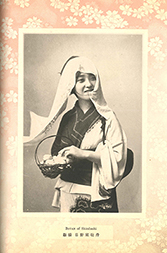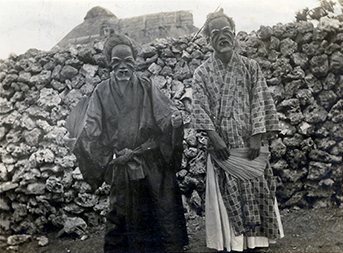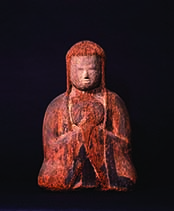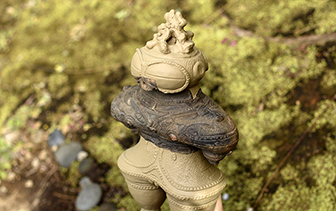 |
Focus features two in-depth reviews each month of fine art, architecture and design exhibitions and events at art museums, galleries and alternative spaces around Japan. The contributors are non-Japanese art critics living in Japan. |
|
|
 |
 |
 |
Idolizing Beauty: Ancient to Now
Lucy Birmingham |
 |
Mai Fuchigami banner, 21st century; collection of the HKT48 Mai Fuchigami fan club. |
Think "archeology museum in Tokyo" and it's easy to imagine badly lighted, crumbling displays in a decrepit space reeking of mildew. And yet there is a new and seemingly unknown archeological gem of a museum close to the heart of Shibuya that is redefining that image.
About ten minutes' walk from Shibuya Station, the Kokugakuin University Museum boasts a sleek space built in 2013, with state of the art displays and LED lighting that captures the beauty and mystery of its 10,000-piece collection of Japanese archeological finds and Shinto-related statues, scrolls, screens and altars.
Uriame Dohei den (Story of Candy Vendor Dohei), written by Chikura Sanjin and illustrated by Suzuki Harunobu, 1769; private collection. |
|
Biensennyo-ko (Face Powder), illustrated by Keisai Eisen, 19th century; private collection. |
The museum is a merger of two former institutions: the Museum of Archeology, founded in 1928, and the Shinto Museum, established in 1963. Its aim, backed by 130 years of scholarly research, is to preserve and share Japan's material ancient history and its immaterial spiritual traditions.
Carrying on this mission is a team of young, internationally minded curators and professors with such unique approaches they're likely raising eyebrows among the many conservative academics in the field. Yes, their exhibitions remain grounded in Japan, but also cross national borders. And rather than sticking just to Shintoism (Japan's indigenous religion), they've tested the waters with exhibitions on Judaism, Islam, Taoism, and Shugendo (a Japanese mountain ascetic practice similar to shamanism).
 |
|
 |
|
Photo from Tokyo hyaku bijin (100 Tokyo Beauties), edited by Kazumasa Ogawa, 1902; private collection. |
|
Angama performers, Ishigaki island, Okinawa Prefecture, photograph by Shinobu Orikuchi, 1923; Dr. Orikuchi Memorial Ancient Research Institute, Kokugakuin University collection. |
Their ongoing show until June 12, The Genealogy of Japanese Idols, plays with the definition of idols in their varying incarnations and the worship they inspire. Examples range from prehistoric pottery to modern-day pop figures.
Lead curator Taro Fukasawa admits his recent unabashed fascination with the theme. "I'm a fan of HKT48's Mai Fuchigami," he says when explaining his inspiration for the exhibition. "She's a singer with the pop idol group Hakata48 based in Fukuoka city. I like to go to the handshake events." The Kokugakuin University assistant professor says he also had in mind a clever hook to attract visitors to the show.
Iwato kagura no kigen, illustrated by Utagawa Toyokuni III, 19th century; Dept. of Shinto Culture, Kokugakuin University collection. |
During a backroom tour before the opening, Fukasawa and curator colleague Leela Jinnouchi showed me an Edo-era picture book published in the 1770s about a 17- or 18-year-old girl named Osen. Magazine-like printed booklets, as well as ukiyo-e prints -- both popular media of the day -- spread word about the charming waitress at a tea café in what is now Tokyo's Yanaka district. Osen ultimately became a goddess-like icon loftier than today's "Mai-chan" in a budding idol industry that churned out sweet, dreamy images of beauty.
Female idol figures, I quickly learned, have been a successful phenomenon since ancient times. Examples in the show include original Haniwa terracotta clay figures from the Kofun period (3rd to 6th century). Formed with breasts and jewelry-shaped ornamentation, these funerary objects were placed in tombs as symbols of the carnal and sacred festivals of the day, where music, dance and trance flowed. They were a precursor of the dances and prayers first performed at Shinto shrines in the 12th-century Heian period, explains Fukasawa. "It was the dawn of the performing arts in Japan, a ritual connection between art and the gods."
 |
|
 |
|
Wooden sitting statue of female deity, 16th century; Kokugakuin University Museum collection. |
|
Shakoki dogu (goggle-eyed clay figure), Tohoku region, middle part of final Jomon period; Kokugakuin University Museum collection. |
The exhibition's themes -- idols, worship, performance, art, and goddesses through time -- combine in Iwato kagura no kigen (The Origins of Sacred Dance at the Heavenly Cave). The richly colored 1844 ukiyo-e print by Utagawa Kunisada I portrays the legend of the beautiful Sun Goddess, Amaterasu. Long story short: Erotic dancing and clapping by gods gathered outside her hermit cave induced her to step out and join the fun. With this, she let her sunlight shine again and the Earth was whole once more.
The beauty of idols, skillfully packaged with help from artists and the media, is the stuff of legends. But when she is a goddess, the figure is out of reach, a stretch of the imagination. And yet the 3D vocaloid Hatsune Miku, Japan's modern-day, goddess-like virtual idol, has taken the concept to a whole new stage. In the future, what form will our idols take? Hopefully, we will still be able to shake their hands.
|
All images are courtesy of the Kokugakuin University Museum.
|
 |
 |
Lucy Birmingham
Lucy Birmingham is a long-time, Tokyo-based journalist, scriptwriter, author, and former photojournalist. She recently served two years as president of the Foreign Correspondents' Club of Japan. She has written regularly for TIME magazine and her articles have appeared in many publications, including the Wall Street Journal, Newsweek, Bloomberg News, and Architectural Digest. As an arts and culture writer her articles have appeared in publications including Artinfo.com, Artforum.com, and ARTnews. She is also a scriptwriter and narrator for NHK (Japan's public broadcaster) and has published several books including Strong in the Rain: Surviving Japan's Earthquake, Tsunami, and Fukushima Nuclear Disaster. lucybirmingham.com |
|
 |
|